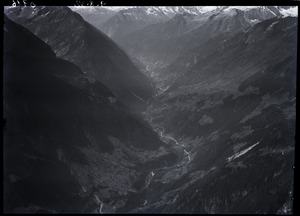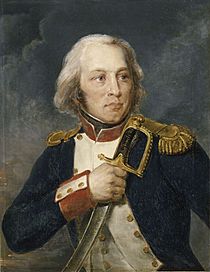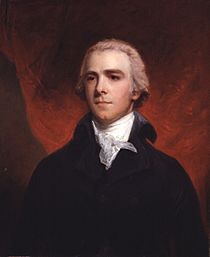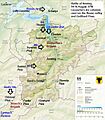Battle of Amsteg facts for kids
Quick facts for kids Battle of Amsteg |
|||||||
|---|---|---|---|---|---|---|---|
 Amsteg and the Reuss River (1932) |
|||||||
|
|||||||
| Belligerents | |||||||
| Commanders and leaders | |||||||
| Strength | |||||||
| Casualties and losses | |||||||
| Battle: 500 Campaign: 1,500 |
Battle: 2,300, 3–12 guns Campaign: 7,500, 12 guns |
||||||
The Battle of Amsteg was a fight that happened from August 14 to 16, 1799. It was part of the War of the Second Coalition. In this battle, French soldiers led by General of Division Claude Lecourbe fought against Austrian soldiers led by General-major Joseph Anton von Simbschen.
Lecourbe's attack started on August 14. French soldiers marched into the upper Reuss valley from the north and east. By August 16, the French had pushed the Austrians out of the valley. They took control of the important Gotthard Pass, which connects Italy and Switzerland.
Earlier, on June 4, the First Battle of Zurich took place. French General André Masséna fought against an Austrian army. After this battle, Masséna had to leave Zürich. He moved his army to a strong defensive spot west of the city. He also told Lecourbe to leave the Gotthard Pass and go back to Lucerne.
But in August, Masséna changed his mind. He wanted Lecourbe to get the Gotthard Pass back. Masséna was worried that Austrian and Russian armies might attack from Italy through the pass. So, he ordered an attack to take over the area. Other French divisions also attacked different Austrian positions. This was to stop the main Austrian army from helping the Austrians at Amsteg.
Contents
Understanding the Battle's Background
Earlier Fights and Changes
General Lecourbe had been fighting in the Engadine campaign earlier in 1799. He won a battle on March 12. By May, he had moved his troops to Bellinzona, leaving the Engadine area.
Around the same time, a rebellion started in some Swiss areas. This cut off communication for the French army. General Masséna sent General Jean-de-Dieu Soult to stop the rebellion. Soult managed to calm some rebels. He also fought hard to push rebels out of the upper Reuss valley. He captured the Teufelsbrücke (Devil's Bridge) before it could be destroyed. On May 15, Soult's troops met other French soldiers near the Gotthard Pass.
Masséna then ordered Lecourbe to pull back. By May 24, Lecourbe was at Altdorf in the upper Reuss valley. Meanwhile, Austrian forces began moving into the Gotthard Pass area. On May 29, Austrian soldiers defeated some French troops in the Urseren valley. But on May 31, Lecourbe fought back and defeated the Austrians at Wassen. On June 2, Lecourbe pushed the Austrians back across the Devil's Bridge. The Austrians destroyed the bridge, and some of their soldiers were trapped and had to surrender. After this, Lecourbe left the upper Reuss valley and moved to Lucerne.
On June 4, the First Battle of Zurich happened. Archduke Charles, leading 53,000 Austrians, attacked Masséna's 45,000 French soldiers. The Austrians won, but both sides had many losses. Masséna decided to pull back from Zürich to a stronger position.
Military Plans and Decisions
At this time, Masséna's French army was spread out across Switzerland. Lecourbe's division was on the right side, near Lucerne. Other divisions held lines near Zürich and along rivers. The French had many soldiers, but not all were ready for battle.
The Austrian army, led by Archduke Charles, also had many soldiers. Some were watching the French along the Rhine River. Other Austrian troops held important mountain passes like the Gotthard Pass. Archduke Charles believed that attacking the French near Zürich would cost too many lives. He decided to wait for a Russian army to join him.
Meanwhile, British leaders were making a big plan for the Allied armies. William Grenville, 1st Baron Grenville, a British government official, came up with an idea. He wanted a large Russian army to join another Russian army in Switzerland. This combined force would push the French out of Switzerland. Then, they would attack France itself. Archduke Charles and his Austrian army would move to Germany and attack France from there. Another British and Russian army would invade a French-controlled area in the north.
This plan was approved by the Russian and Austrian emperors. However, when Archduke Charles heard about it on August 7, he had doubts. The Russian general, Alexander Korsakov, was also surprised. He said his army was much smaller than the British thought. This plan, which seemed good on paper, would later cause problems for the Allied forces.
The Battle of Amsteg
Masséna decided that taking back the Gotthard Pass was very important. It would protect his army from behind and open up a way to connect with the French army in Italy. He didn't know that a large Russian army would soon try to cross the pass, but he knew it was a possibility.
Lecourbe's attack to capture this key area lasted from August 14 to 16, 1799. He had about 10,000 to 12,000 soldiers. Simbschen's Austrian force had about 4,400 soldiers.
Lecourbe split his soldiers into six groups.
- One group attacked southeast towards Schwyz. In the Battle of Schwyz on August 14, the French pushed the Austrians out of the town. The French had about 168 casualties, while the Austrians had more.
- Lecourbe himself led a second group. They crossed Lake Lucerne by boat and landed at Flüelen.
- Other groups marched through mountain passes to join Lecourbe. One group crossed the Surenen Pass to reach Erstfeld. Another hiked across the Susten Pass to Wassen.
As the French advanced, Simbschen's Austrians pulled back to the Devil's Bridge. They broke the bridge to stop the French. Farther west, another French group under General Gudin moved up the Aare valley. Gudin's 2,400 soldiers surprised the Austrians at the Grimsel Pass. The Austrians suffered heavy losses and were forced to retreat.
Another French division, led by General Louis Marie Turreau, advanced from the southwest. Turreau's troops met Gudin's soldiers. The Austrian survivors were caught between the two French forces and had to retreat into Italy. Turreau then took control of the Grimsel Pass. He had also defeated Austrians in another battle nearby.
When Simbschen realized that Gudin's soldiers were coming from behind him, he left the Devil's Bridge. He retreated west. Gudin and Lecourbe met up on August 16 and attacked Simbschen together. After a tough fight, Simbschen's Austrians were pushed back to the east. The Austrians lost many soldiers and some cannons. The French had about 600 casualties. The French now controlled the Gotthard Pass and other important mountain passes.
Lecourbe's success was helped by two other attacks. On August 14, French divisions under Soult and Chabran attacked Austrian positions near Zürich. These attacks distracted Archduke Charles. He had to send soldiers to defend Zürich instead of helping Simbschen. This meant Simbschen was left to fight Lecourbe's forces alone.
What Happened Next
In the Battle of Amsteg, the French had about 500 casualties. The Austrians lost about 2,300 soldiers and three cannons. When counting all the related fights, the Austrians lost about 7,500 soldiers and 11 cannons during August 14–16. The French had about 1,500 casualties in total. The French won because they used the Austrians' poor troop placement to their advantage.
On August 15, the Russian and Austrian armies won the Battle of Novi in Italy. The Russian commander, Alexander Suvorov, wanted to finish off the French army there. But the Austrians told him to wait.
Later, Suvorov was ordered to move his army into Switzerland. He asked for a delay, but the Austrian emperor insisted he move immediately. The Austrian emperor also demanded that Archduke Charles leave Switzerland at once. This plan, however, had bad timing. Charles left Switzerland too early, and Suvorov arrived too late. This left other Allied armies in a dangerous position against Masséna's French army. Masséna would use this mistake to his advantage in the Second Battle of Zurich in late September. Meanwhile, Suvorov would have to recapture the Gotthard Pass on September 24.
Images for kids










